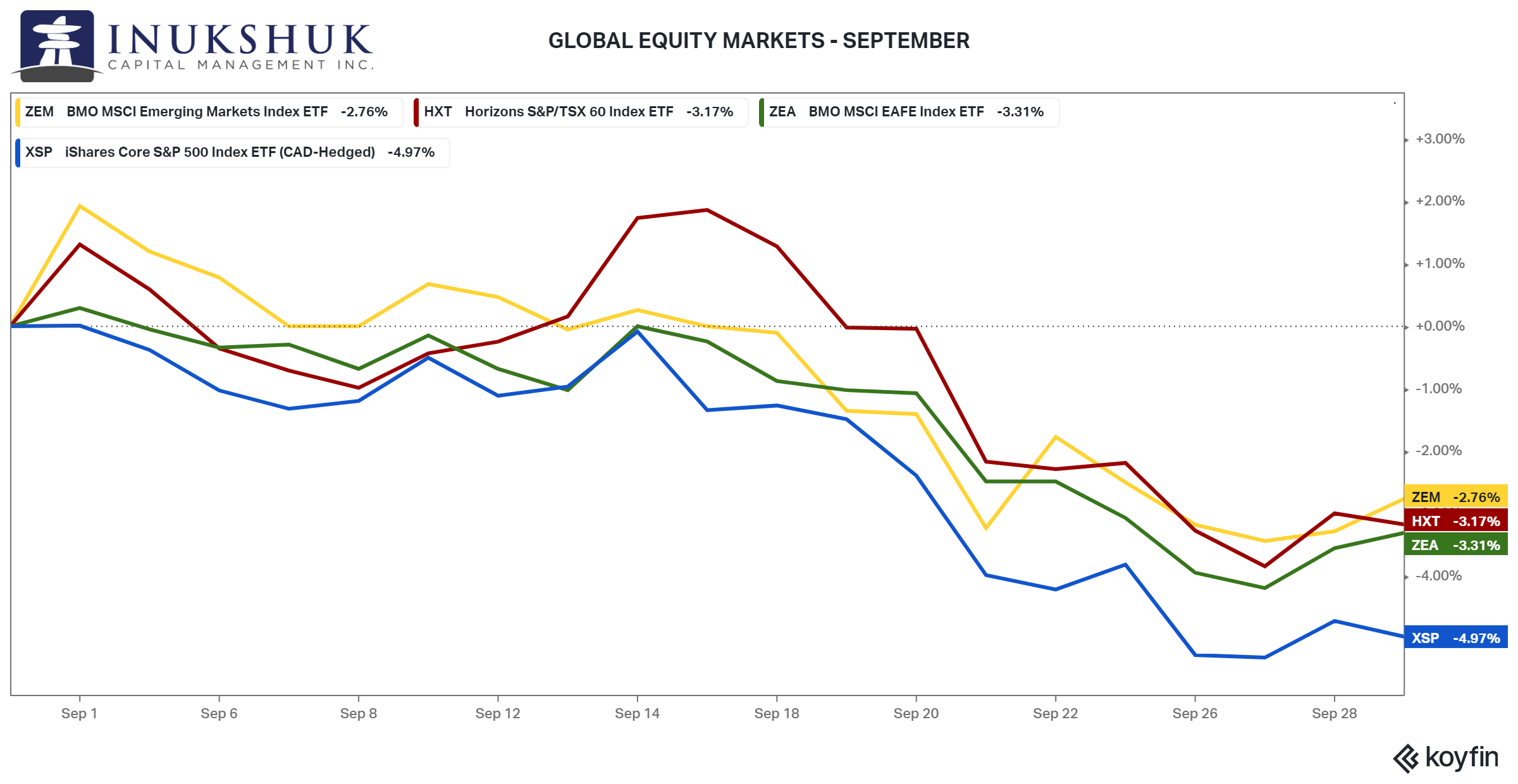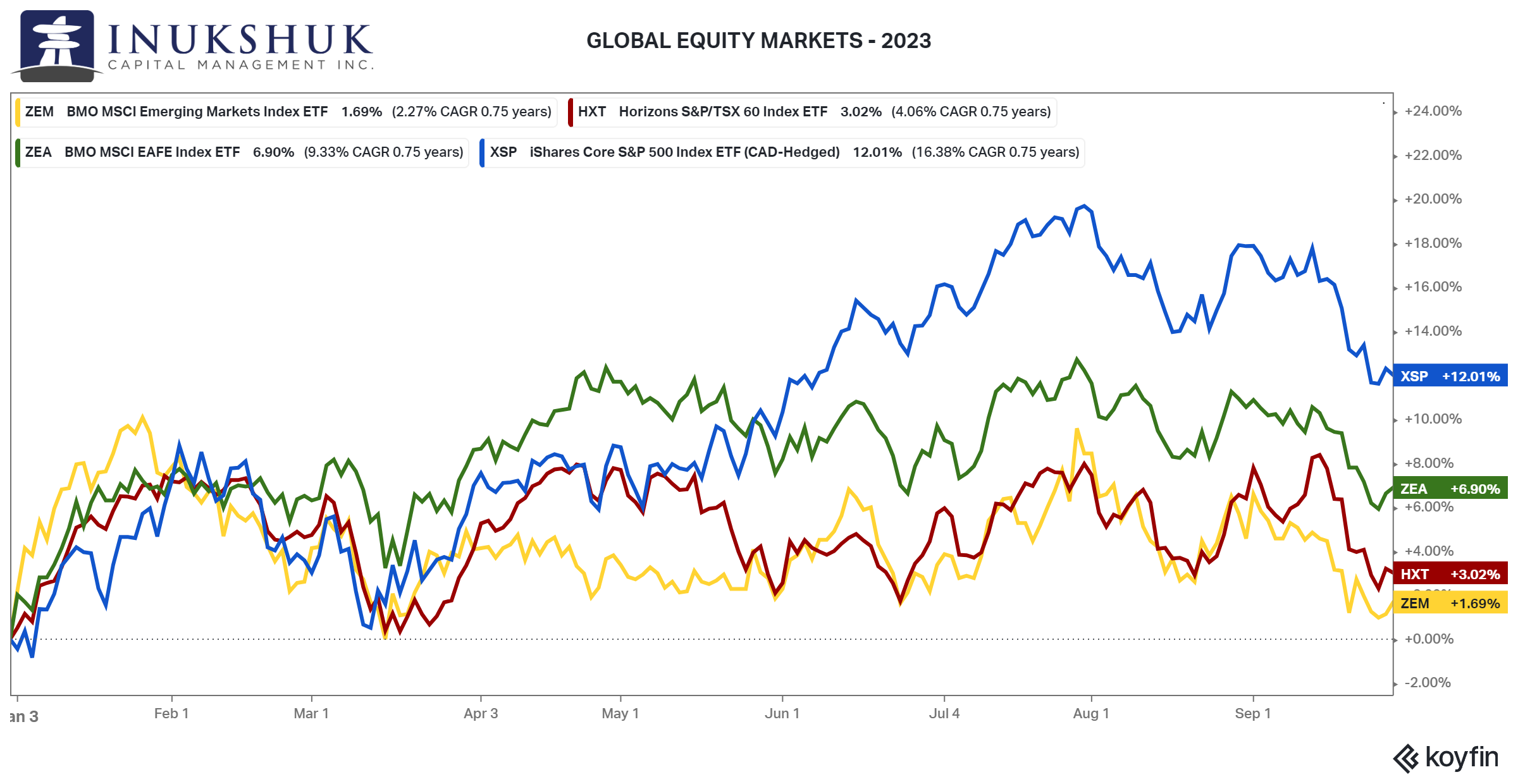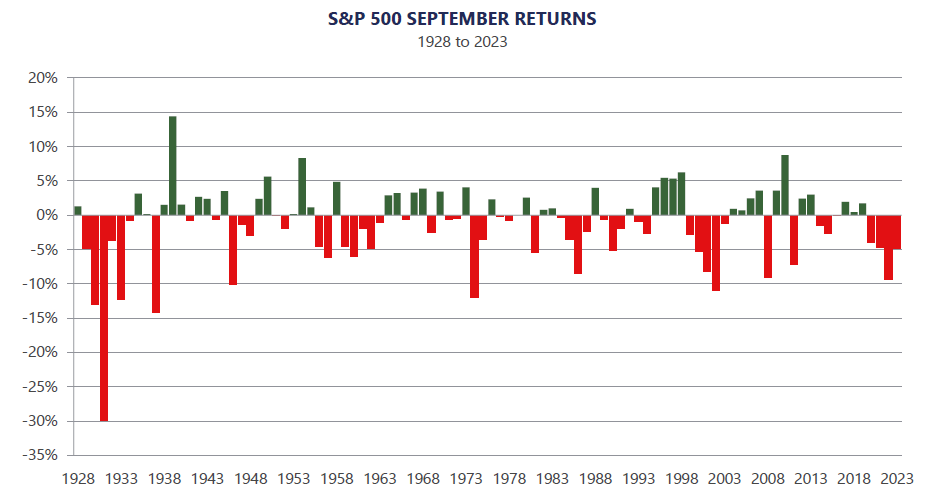Hearts on Fire
We built Inukshuk Capital Management to serve the needs of clients looking for a unique approach – void of conflicts of interest, commission sales and pushed products. We began by putting our own money where our mouth is. With low fees and active risk management, we help families achieve financial longevity, that’s the bottom line.
Stay up-to-date on the latest developments by following us on LinkedIn here.
October 2023: Fall
In this issue:
- Global Equity Market Performance
- Fall
- October
- Down More Than Up
- Follow Through?
- Wrapping Up
- Health is Wealth
GLOBAL EQUITY MARKET PERFORMANCE
September was one of the worst months in some time. This follows up on a negative August where North American and international markets were all down roughly 1.5%. This month, the top performers (if you can say performers), Emerging Markets, the S&P/TSX60 and MSCI EAFE were all down around 3% with the S&P 500 falling almost 5%.
Since we are headed into the last quarter of ‘play’ this year let’s take a look at how things have evolved.
At the end of July the S&P 500 was up close to 20%. It is now up 12%. Emerging Markets have pretty much gone nowhere. The S&P/TSX60 and MSCI EAFE have been drifting sideways since March, up 3% and 6% respectively.
Our systems continue to remain fully long the S&P 500 and S&P/TSX60 although the warning signs for Canada we mentioned in the last note continue to persist.
If you would like to stay current on our measures of trend and momentum in the markets we follow, please click here .
FALL
It’s not called fall for no reason. The original name for the season, according to Merriam-Webster, was autumn, which replaced harvest. Harvest was a bit confusing since it could be a noun or a verb. English writers then introduced the phrase ‘the fall of leaves’ which was subsequently reduced simply to fall. The Americas took it up and here we are. It’s fall.
Not only do leaves fall from trees at this time in the northern hemisphere (the Leafs are just getting started) but stocks do too. Or it seems they do. Why this happens nobody knows but it does occur frequently enough for people to notice. So let’s have a look as to whether this is true
OCTOBER
Actually it is. Despite many memorable instances of stock market debacles in October, September takes the cake (pumpkin pie?). October 1929 was a spectacular wipeout. By November the Dow Jones Industrial Average had lost half of its value and the Great Depression ensued. October 19, 1987 was one of the all-time top crashes and got branded ‘Black Monday’. The S&P 500 fell 22% that day. In 2008, after Lehman Brothers collapsed, it fell 17% after losing 9% in September.
Considering all of that, the month of October is not a real standout in terms of performance over the past 96 years. Looking at the numbers it is a down month around 40% of the time. And the odds of any month being down are… 40%.
DOWN MORE THAN UP
Now let’s check out September.
There is a real doozy in there. 1929. Other than that it looks like a series of bad performance that is not matched by good performance. It has been a down month 56% of the time. The average of losses is almost identical to the average losses of October at around 5%. The thing is: the average gain in October is 6% versus less than 3% for September. That’s the difference.
FOLLOW THROUGH?
Our systems are built on a well researched and substantiated practical approach to large markets where many players are making millions of decisions constantly. Price is all that matters. They are based on measuring trends. So here is a question, just for fun: if September is bad does that mean October will be as well?
Not necessarily, is the answer.
Over the past 96 years the S&P 500 has been down 54 times in September. Following a negative September, it has been up 30 times in October. That’s a .560 batting average, which isn’t too far from months that don’t start with the letter S. The odds are 60% that any month will be positive. Our systems work on a longer timeframe for many reasons and this would be one of them.
The lesson is: Looking at various numbers and reading stories about past events is not enough. In order to effectively manage risk, it requires that your observations aren’t mere headlines but are instead based on large amounts of data.
WRAPPING UP
As of this writing global equity markets are in positive territory for the month. This despite an ongoing war in Ukraine and, most recently, one of the most horrific terrorist attacks Israel has ever had to endure. No words. Instead see the painting above: ‘Hearts on Fire’.
Now, let’s turn it over to Victoria, who will explain how changing seasons affect your health, regardless of what is happening in the markets or the world.
HEALTH IS WEALTH
Finding Serenity in the Changing Seasons
As we bid farewell to the scorching days of summer and welcome the cool embrace of fall, the world undergoes a transformation that is not just visual but deeply sensory. This annual transition isn’t just a change in temperature and light; it’s a shift that can significantly affect our physical and emotional well-being. It is important for our overall health to recognize the impact of seasonal changes and explore ways to harness the serenity that can come with it.
Moving from summer to fall, the days become shorter and the temperature drops. This shift in seasons can influence our physical health. For instance, the reduced daylight can impact our vitamin D levels, which are crucial for immune health and mood regulation.
According to the National Institutes of Health, vitamin D deficiency has been associated with an increased risk of various health issues, including depression, and weakened immune function. Therefore , it’s vital to be aware of the changing light patterns and consider supplements or spending more time outdoors to maintain your health.
The transition from summer to fall can also have a profound emotional impact. The shorter days and fading sunlight can lead to a condition known as Seasonal Affective Disorder (SAD). This type of depression is often linked to changes in light, and its symptoms include low energy, moodiness, and feelings of sadness. It’s estimated that millions of people are affected by SAD, emphasizing the need to address these emotional changes as part of our commitment to health.
Amidst the hustle and bustle of our modern lives, the shift from summer to fall provides a unique opportunity to reconnect with nature. Serenity can be found in the beauty of the changing leaves, the crispness of the air, and the sound of leaves rustling in the wind. Taking time to appreciate these simple yet profound pleasures can be a therapeutic experience.
To achieve serenity in this season of change, consider the following:
- Mindful Reflection: Spend time in quiet contemplation, reflecting on the past months and your goals for the future. Acknowledge your emotions, even if they are challenging, and practice self-compassion.
- Nature Walks: Embrace the outdoors. Take leisurely walks in the park or the woods and immerse yourself in the colors and scents of fall. This connection with nature can alleviate stress and boost your mental well-being.
- Healthy Habits: Maintain a balanced diet and regular exercise routine. The change in seasons is an ideal time to adapt your habits to the shifting energy around you.
- Connection: Reach out to friends and family. As many people are hurting emotionally due to various stressors, a supportive community can be a source of solace and strength.
- Creativity: Engage in creative activities that bring you joy, such as painting, cleaning, writing, or crafting. These activities can be soothing and therapeutic.
In today’s world, where we are often bombarded with unsettling news and events, finding serenity becomes increasingly vital. It is a reminder that even in the face of turmoil and chaos, we can ground ourselves in the natural world and find peace within. In serenity we find strength, and in our well-being, we find health. Health is wealth.
‘You have to sustain it, to maintain it’
Victoria Bannister
ICM Health Ambassador
Have a question? Contact us here
Challenging the status quo of the Canadian investment industry.
















